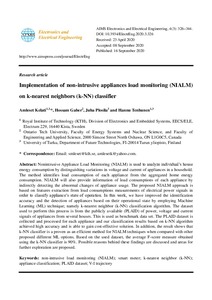Implementation of non-intrusive appliances load monitoring (NIALM) on k-nearest neighbors (k-NN) classifier
Amleset Kelati; Hossam Gaber; Juha Plosila; Hannu Tenhunen
https://urn.fi/URN:NBN:fi-fe2021042826300
Tiivistelmä
Nonintrusive Appliance Load Monitoring (NIALM) is used to analyze individual’s house energy consumption by distinguishing variations in voltage and current of appliances in a household. The method identifies load consumption of each appliance from the aggregated home energy consumption. NIALM will also provide information of load consumptions of each appliance by indirectly detecting the abnormal changes of appliance usage. The proposed NIALM approach is based on features extraction from load consumptions measurements of electrical power signals in order to classify appliance’s state of operation. In this work, we have improved the identification accuracy and the detection of appliances based on their operational state by employing Machine Learning (ML) technique; namely k-nearest neighbor (k-NN) classification algorithm. The dataset used to perform this process is from the publicly available (PLAID) of power, voltage and current signals of appliances from several houses. This is used as benchmark data set. The PLAID dataset is collected and processed for each appliance and our classification results based on k-NN algorithm achieved high accuracy and is able to gain cost-effective solution. In addition, the result shows that k-NN classifier is a proven as an efficient method for NIALM techniques when compared with other proposed different ML options. Based on the used dataset, the average F-score measure obtained using the k-NN classifier is 90%. Possible reasons behind these findings are discussed and areas for further exploration are proposed.
Kokoelmat
- Rinnakkaistallenteet [27094]
